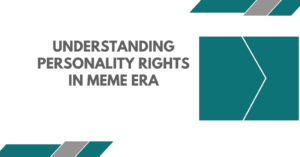When it comes to the creation of Intellectual property the concept of “work for hire” plays a pivotal role, especially in the domains of copyright and patent law. This legal principle determines who holds the ownership of intellectual property created in the course of employment or under a contractual agreement. While the idea of “work for hire” may seem straightforward, its implications can be complex and vary significantly between different types of IP, such as copyrights and patents. This article explores the concept of “work for hire” in the context of Indian law and how it affects ownership and rights related to copyright and patents.
What is “Work for Hire”?
The concept of “work for hire” refers to a situation where a person or entity, typically an employer or contractor, hires an individual (an employee or an independent contractor) to create a specific piece of intellectual property, and as a result, the ownership of the work is automatically assigned to the hiring party.
In the Indian IP context, work for hire influences two major areas:
1. Copyrights (for creative works like writings, music, films, software, etc.)
2. Patents (for inventions and innovations).
The way “work for hire” operates under Indian law differs slightly in each of these categories, and understanding these distinctions is crucial for creators, employers, and businesses alike.
Work for Hire in Indian Copyright Law
Legal Framework
In India, copyright is governed by the Copyright Act, 1957. Under this Act, the principle of “work for hire” is enshrined in Section 17, which deals with the ownership of copyright. Generally, the author or creator of a work is the first owner of the copyright. However, there are exceptions to this rule, one of the most significant being works created under employment or commission, which are considered “works for hire.”
Ownership of Copyright
According to Section 17 of the Copyright Act, the employer or commissioning party will be the first owner of the copyright in the following cases:
1. In the Course of Employment: If a work is created by an employee in the course of their employment, the employer is deemed the first owner of the copyright, unless there is an agreement to the contrary.
2. Commissioned Work: If a work is created on commission for a specific purpose, the party commissioning the work will own the copyright unless there is an agreement to the contrary.
In the case Khemraj Shrikrishnadass v. M/s Garg & Co., the court addressed the issue of copyright ownership concerning work for hire under Indian law. The court held that in the absence of a contract stating otherwise, when an author creates a work at the request of another party for remuneration, the copyright typically passes to the person who commissioned the work. This reinforces the general principle that unless an explicit contract exists, the employer or commissioner becomes the first owner of the copyright in such works created during employment or as commissioned assignments.
Moral Rights
Even though the employer or commissioning party owns the copyright, the creator still retains moral rights under Indian law, including the right to claim authorship and prevent modifications that could harm the creator’s reputation.
Work for Hire in Indian Patent Law
Legal Framework
In India, patent rights are governed by the Patents Act, 1970. Unlike copyright, where the work-for-hire principle is relatively clear, patent law presents a more nuanced situation. Ownership of a patent typically depends on the terms of employment and whether the invention was created within the scope of the inventor’s duties.
Ownership of Patents
There is no automatic “work for hire” rule for patents in India as there is in copyright law. Instead, the inventor is considered the “first owner” of the patent and the ownership of inventions depends on the terms of the employment contract or a specific assignment agreement. This means that while an employee is the actual inventor, ownership of the patent can only be transferred to the employer through a written contract or agreement. Furthermore, there is always a separate debate about the inventions created by the employee during the course of employment and since the inventor (employee in this case) is the first owner of the patents the Employers are advised to always execute a assignment agreement in place.
1. In the Course of Employment: If an employee invents something as part of their job duties (e.g., researchers, engineers), the employer generally owns the patent subject to the assignment agreement.
2. Outside Employment Duties: If an employee invents something unrelated to their job description and outside the use of company resources, the employee may have the right to the patent.
The case of Darius Rutton Kavasmaneck v. Gharda Chemicals Ltd. (2014) revolves around a dispute concerning intellectual property rights in the context of patent law and “work for hire.” The case involved the question of whether the inventions and patents developed by Kavasmaneck, a key employee of Gharda Chemicals, belonged to him individually or to the company. The court ruled in favor of Gharda Chemicals, affirming that the inventions created by Kavasmaneck during his tenure with the company fell under the “work for hire” doctrine, as they were made in the course of his employment and used the company’s resources. This case highlights the importance of employment agreements and the principle that inventions made by employees in the scope of their work duties are typically owned by the employer
Comparing Copyright and Patent Work for Hire
While the concept of work for hire is prevalent in both copyright and patent law, there are some key differences:
1. Automatic Ownership:
– In copyright, the employer or commissioner is typically the automatic owner unless there is an agreement to the contrary.
– In patent law, ownership depends on the employment context and the existence of a clear agreement, as the inventor is the first and original owner by default.
2. Scope of Work:
– In copyright, almost any work created within the course of employment may fall under work for hire, regardless of the employee’s specific role.
– In patent law, only inventions created within the scope of the employee’s role as an inventor (such as in R&D) typically belong to the employer.
Conclusion
The concept of “work for hire” is an essential aspect of intellectual property law in India, defining how ownership is assigned in both copyrightable works and patentable inventions. For employers, employees, and independent contractors alike, it is critical to have clear agreements in place to establish ownership of IP created during the course of employment or contract. The case laws discussed highlight that Indian courts generally favor employers in matters of work for hire, particularly in copyright law, while patent law provides more room for negotiation and interpretation.
Understanding the nuances of “work for hire” ensures that all parties involved can protect their intellectual property rights and avoid potential disputes.










